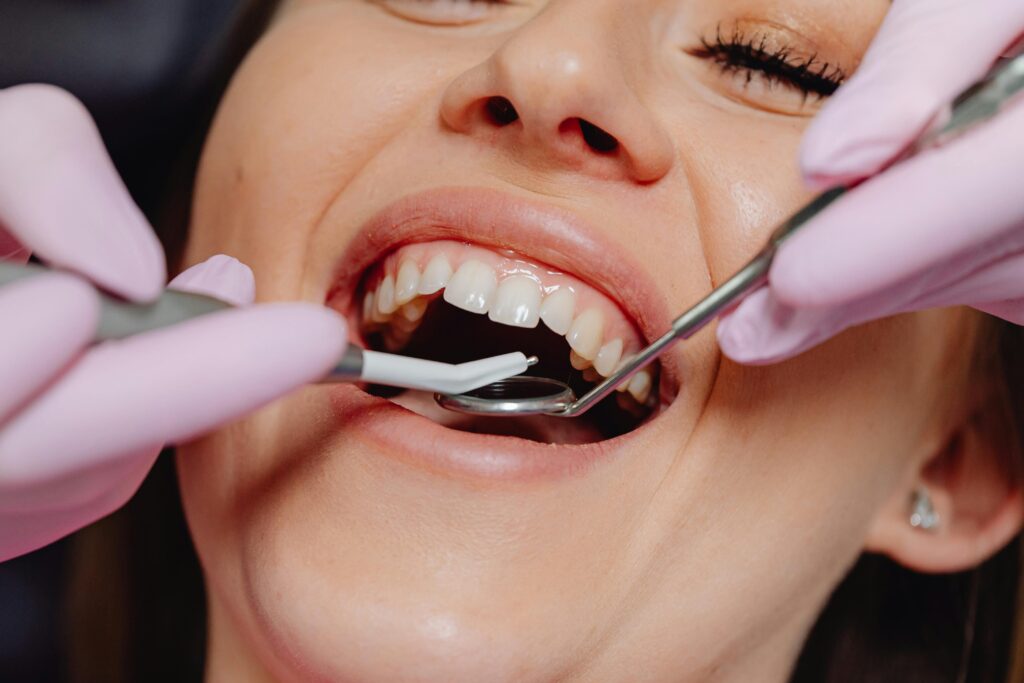
Cavities, also known as tooth decay or caries, are a common dental problem that affects people of all ages. According to the World Health Organization, dental caries is the most prevalent noncommunicable disease globally, with an estimated 2.3 billion people suffering from caries of permanent teeth and over 530 million children with caries of primary teeth.
Roughly 90% of adults in America have had or have a cavity. This is a staggering number. And it shows a serious problem for both people’s oral health. And since the first step of any problem is to understand what causes it, we’ll discuss what causes cavities in this article. Keep reading!
What causes cavities?
Tooth decay, or a cavity, occurs when the tooth’s surface, or enamel, is damaged. This damage is caused by a buildup of plaque, a sticky mix of bacteria, acid, food, and saliva that forms on our teeth. When we consume foods and drinks that contain sugars and starches, the bacteria in plaque feed on these carbohydrates and produce acid as a byproduct. Over time, this acid can erode the enamel and lead to the formation of cavities, or holes on the tooth surface.
Dietary factors
While bacteria play a significant role in the development of cavities, our diet also has a substantial impact. Foods and drinks high in sugar and carbohydrates provide the perfect fuel for cavity-causing bacteria. In fact, a systematic review published in the Journal of Dental Research found a positive association between sugar consumption and the development of dental caries.
Other risk factors
In addition to your diet, several other factors can increase the likelihood of developing cavities:
- Dry mouth: Saliva helps neutralize acid and wash away food particles. Certain medications, medical conditions, and habits can reduce saliva flow, making the teeth more vulnerable to decay.
- Family history: Your genetics can also have an impact on your risk of getting cavities. In fact, 60% of tooth decay cases appear to be due to genetic factors, like a preference for sweets, the strength of your teeth enamel, and saliva composition.
- Inadequate oral health: Poor oral health habits like brushing, flossing, and getting dental cleanings allow plaque and bacteria to build up, leading to tooth decay.
- Chemotherapy or radiation therapy: Chemotherapy and radiation therapy can cause changes in your salivary glands, which can lead to tooth decay.
- Location of the tooth: Your back teeth, like molars and premolars, are more prone to cavities because their grooves and pits can trap food and bacteria. They are also harder to clean than your front teeth as they are hard to reach!
Prevention and treatment
Preventing cavities involves a combination of good oral hygiene habits. These include:
- Brushing twice a day: Brushing your teeth twice daily is important for removing food particles and plaque. Choose a fluoride toothpaste, as fluoride strengthens enamel and can even help stop early decay. Be thorough when brushing, reaching all surfaces of each tooth that you can.
- Flossing daily: Food particles can often get between teeth where a toothbrush can’t reach. Flossing once a day removes plaque and food particles stuck in these tight spaces, preventing cavity formation and maintaining healthy gums.
- Limiting sugary foods and drinks: As sugar can lead to tooth decay, it’s important to minimize sugary snacks and beverages, especially those high in refined sugars. Foods like candy, soda, and certain fruit juices should be limited, while water, dairy, and fibrous vegetables are tooth-friendly options.
- Getting regular dental check-ups and cleanings: Seeing your dentist every six months allows for the early detection of cavities and other dental issues before they worsen. Professional cleanings remove tartar—hardened plaque that can’t be removed with regular brushing—reducing the likelihood of decay.
- Using a mouthwash with fluoride: Consider incorporating a fluoride mouthwash into your routine to add an extra layer of protection against cavities.
While prevention is the goal, if a cavity does develop, it’s important to get treatment. This typically involves removing the decayed portion of the tooth and filling it with dental material (dental fillings). In more severe cases, a crown, onlay, or root canal may be necessary to restore the tooth’s function and prevent further damage.
Visit Dr. Ruiz & Associates, Inc for a dentist in Burbank, CA
Now that you know what causes cavities, you can do something about it! If you’re in the burbank area and are looking for a dentist to get tooth-colored fillings, come visit our office, Dr. Ruiz & Associates, Inc!At our office, you will enjoy a world-class dentistry that utilizes the latest techniques and technology, led by Dr. Ruiz, a leading researcher, educator, and dentist who has trained over 3,000 dentists worldwide. Check out our Google reviews and schedule an appointment with us!




